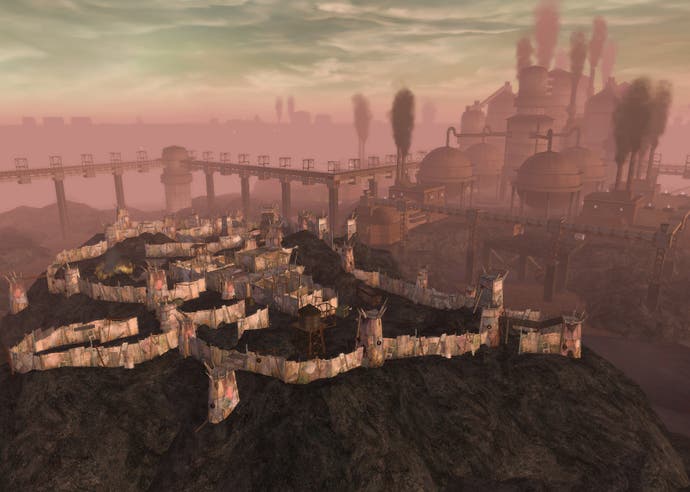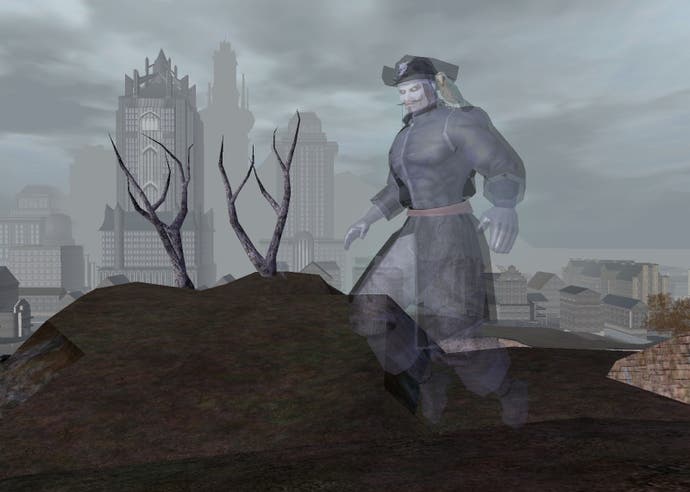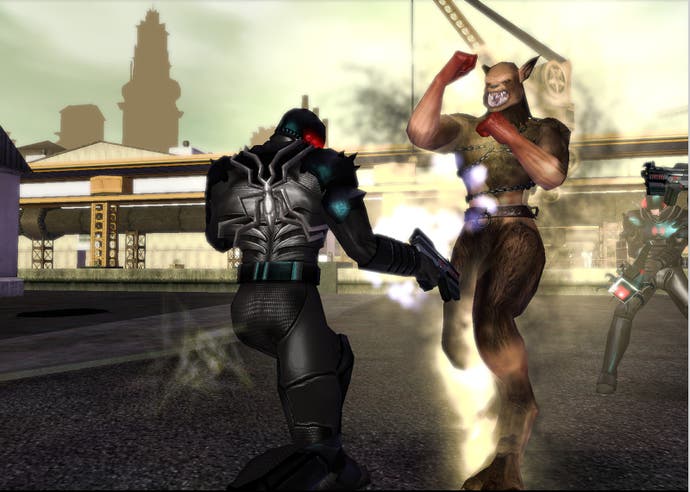City of Villains
Leave Bristol alone.
December is going to present a dilemma, and more than worrying about whether I'd rather spend Christmas in Bristol or Stafford or how little I can spend on presents for people I don't really like without offending them too much. The Christmas spirit of gleeful hypocrisy lives.
It'll be time for Eurogamer's top 50 games of the year, and we'll have to deal with the fallout of last year's. One of the rules was that it's a Top 50 of games released in the UK. In other words, no imports. Now, my game of the year - the one which I played most, to a physically debilitating degree and thought pushed the edge of pop-gaming culture hardest - was City of Heroes. And it was ineligible, because I bought and downloaded it online and it didn't receive an official UK release until this spring.
The dilemma is going to be how much residual critical standing does City of Heroes carry over to this year. I've played it a load this year, obviously, and it's still a brilliant game - but it's not a game that's defined the year, so it's going to hurt its standing. Damn multi-region releases.
(It's going to hurt Shadow of the Colossus for next year too, I think, but that's another story.)
I dunno what to do. Any advice in the comments would be gratefully accepted.
This review poses a dilemma too, of a different sort, and but I've had to work out an answer myself.

City of Villains is extremely similar to City of Heroes, with you playing (er) Villains. Its differences are core fundamental dynamics whose changes sneak up on you or surface gloss or additions lumped on the side. As the sequel to City of Heroes which it protests to be, you'll have to be disappointed and mark accordingly.
But it's not that simple. It's less of a true sequel, and more of a sister-game that sits beside City of Heroes. A companion piece, if you will. If you're already subscribing to City of Heroes and you buy City of Villains, your subscription fee will cover both. In other words, it actually operates as a particularly baroque expansion pack. And this too sounds like a little brush off, until you stress that - in these terms - it's one of best add-on packs ever made. For an MMO, probably the best ever. For the £18 you'll pay for it from an online retailer, you're getting a serious amount of content for your money.
That's my answer to this dilemma: City of Villains is an exquisitely constructed expansion pack for anyone who liked City of Heroes, which also acts as a new entrance point into the world for the uninitiated.
The core values remain the same. It's deliberately aimed shallower than most MMOs, concentrating almost entirely on the combat aspects. The missions that are offered weigh heavily on instanced areas, where only you, your party and your opponents exist so preventing random people wandering up and annoying you. It pays far more attention than the competition to matters of atmosphere and style - civilians in the street chat about your exploits, enemies stand blankly waiting to get killed like in most of its rivals, rather act out intricate scenes, and you have more costume-customisation options in the first four seconds of the game than others manage in their entirety.
The difference is that you're a Villain. And if the game has one main disappointment is that you don't feel as much of one as you may wish. Yes, you're able to dress up in outfits that weigh a lot heavier on the skulls and barbed-wire motifs than before. And, yes, you do a fair bit of bank-robbing and the missions can be generated in a more proactive way (using a newspaper to see things of interest, then going to have a look at them), but for the most part you're running similar tasks to City of Heroes with the mission text changed. Someone looking at the screen couldn't tell the difference between a Villain going to kidnap someone who's being guarded from a Hero going to rescue someone who has been kidnapped. Equally, the sixties-superhero vibe Cryptic's cultivated prevents anything which we'd really consider actually evil in a post-GTA world. Civilians exist happily unmolested. You won't be doing a Bates from Miracleman here.

You psycho.
However, while these game mechanics are similar, the actual implementation has improved considerably. The missions are better written. The contacts you make are realised with wit and charm - I can't remember many of the people who gave me missions in City of Heroes, but characters like The Radio stick in my mind long after I've left their tasks behind. Even the understanding of the city as a storytelling device has improved. As you cross a zone, through observing the architecture and its inhabitants a real sense of place is created. While differences between zones are less than we may have hoped - a decadent, downbeat French vibe is cultivated a little too much - inside a zone you can go from ghettos which exist in constant war between rival gangs to idyllic fortresses of the nouveau-power in a few seconds, and it makes perfect sense.
The villain's archetypes (character classes to you, Mr Trad D&D man) are altered from City of Heroes. While at first glance (in fact, first play) most will come across as similar to the heroes, the further you go the more they distinguish themselves. For example, The Brute may seem as the equivalent of the Tanker, but is far more vulnerable. Instead, he possesses an ability called Fury, which functions in a similar way to the Warrior in World of Warcraft. "However rather than being used to activate powers, it acts as a constant damage modifier. A maxed out Brute will be doing three-times the damage of a chilled out one, meaning that they rush from battle to battle trying to maximise their bonus. It's a berserker class, and judging whether to press on with low health to keep the rage or pullback and recuperate is the key to your success.
I spend a lot of my time staring at the floor.
Another good example is the Stalker. Immediately, you may think him akin to a Scrapper - except this really isn't true (the Brute is actually a fair bit closer, for the record). They're a ninja-styled stealth class, all about hitting with a massive critical attack then hiding as quickly as they can to repeat it. Similar aspects differ the Dominator and the Corruptor from City of Heroes' Controller and the Blaster, respectively. The one class that's immediately unique - and so immediately popular - is the Mastermind, a pet-class who can summon a small army of servants to do their bidding. Their bidding normally being "kill people". It's worth noting that this shows another example of City of Villain's attention to gloriously meaningless personalisation. As well as being able to name them all, a Mastermind can have them worship him or whatever emote they desire. Or, as my team-mates generally do, have them insult other members of the group.
The cads.

As well as standing alone, it's also about integrating with City of Heroes. Player-versus-Player combat is properly supported by City of Villains. While the Arena has existed for some time, the PvP zones are accessible at level 15 which bring the do-gooders and fiendish beasts in direct conflict as they attempt to complete missions in a conflicted zone. While it's got potential, at the moment it's too early to say how it'll play out. While you can enter them before, that most monsters in the first PvP zones are at least level 25 hints where the action will be starting. When the population matures, they'll be a better sense of how it'll work.
The other major cross-game addition is the option of Base-building for your supergroup. As long as your characters are in supergroup mode, they earn prestige for the group which can be spent on outfitting a hideout. Essentially, this is The Sims for the superhero set, allowing a suitably elaborate base to be constructed for the requisite horrific amounts of cash. This also allows more base-raiding PvP as you progress through the game and/or increasingly elaborate interior decorators. We expect all houseguests to be amazed by the enormous stone hand we keep on one room for no discernable reason.
So, what's the final recommendation? Pay attention. Half way up the review: "City of Villains is an exquisitely constructed expansion pack for anyone who liked City of Heroes, which also acts as a new entrance point into the world for the uninitiated." That's exactly it.
Let's say it again.
City of Villains is an exquisitely constructed expansion pack for anyone who liked City of Heroes, which also acts as a new entrance point into the world for the uninitiated.
And the uninitiated really should, as it remains one of the finest online multiplayer games in existence.








